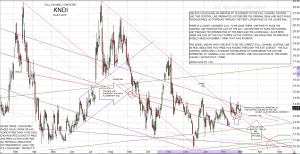The Fall Channel EXIT
 Just what do I mean when I circle an intersection of two lines on a model and call it an “EXIT”?
Just what do I mean when I circle an intersection of two lines on a model and call it an “EXIT”?
I have practically never seen a properly drawn Fall Channel Control Line that is in error. What this means is that as long as my Fall Channel is drawn correctly, and my control line placed correctly, I know exactly where and when price will be at the intersection of the upper rail of the Fall Channel and the Fall Channel Control Line. So far, this has proved true in just under 99% of all Fall Channel models.
I do not know where it will go before that, and I do not know where it will go after that. Nothing in the model can predict that as far as I know. But for that brief moment in time where the two lines cross, I know where price will be. The caveat, of course, is that these lines must be drawn correctly.
Keep in mind that price can fall over an extended period without creating a fall channel at all. This would be simply a downward trading channel. What I am describing here is the fall after a parabolic peak in price, whether located within a downward or an upward trading channel.
Since I know with great certainty that one bit of information, I can plan a trade around it. I do not currently own a margin account, and my broker requires margin accounts to short a stock. Yours probably does as well. But if I wanted to short a stock, the EXIT gives me a very reliable indicator of when and where to expect to close that trade. And so, I would have a reliable indicator of how much gain to expect from a short trade, as a minimum.
Usually price overshoots the EXIT considerably to the downside, and it’s hard to discern any bottom as it occurs, but it should be possible to maximize the gain by closing the short position at a level below the EXIT, and go long to the EXIT.
With long positions I have time to plan trades sometimes months in advance. Some longer Fall Channels develop over months instead of days or weeks. Those longer channels usually have a couple of shorter channels embedded within themselves, offering chances to gain from long positions as price exits one channel and moves to the next. These embedded channels also offer a timing mechanism(their EXITs) that, while not actually indicating the ‘bottom’ of a fall, do offer possibilities to consider against the other lines of force plotted on the model.
Sometimes I will take advantage of these embedded channels and sometimes I do not. I prefer to advantage the overall Fall Channel EXIT, using the embedded channels to time my moves into the stock. It slows me down a bit, gives me more exposure to the stock over a greater period of time. Perhaps years ago I would’ve wanted a more immediate method, but at 55 I don’t mind a slightly slower pace.
So the reason I call it an EXIT is because that point is where I expect to EXIT my trade. After the EXIT, price may rise or it may fall, I have no idea what it’s going to do based on the model. And THAT is why, in most cases, I have to EXIT. There are exceptions, of course.
If price is on a screaming tear through the EXIT then it would be less than wise to close the position. But if price stalls just above the exit and gives indications of falling back, it’s an easy choice. The actual decision to exit the position is always made at the moment, with a bias toward the exit.